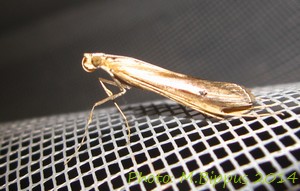Parapodia is a monotypic moth genus in the family Gelechiidae described by Joseph de Joannis in 1859. It contains the species Parapodia sinaica, described by Georg Ritter von Frauenfeld in 1859, which is found in Arabia, the Sinai desert, Palestine and southern France.

Nomophila noctuella, the rush veneer, is a species of moth of the family Crambidae.

Utetheisa pulchella, the crimson-speckled flunkey, crimson-speckled footman, or crimson-speckled moth, is a moth of the family Erebidae. The species was first described by Carl Linnaeus in his 1758 10th edition of Systema Naturae.

Euclasta is a genus of moths of the family Crambidae.

Ochropleura leucogaster, or Radford's flame shoulder, is a moth of the family Noctuidae. The species was first described by Christian Friedrich Freyer in 1831. It is found near the Mediterranean Sea, southern Europe, Turkey, Lebanon, Israel, North Africa and southern Africa as well as on some islands of the Indian Ocean. It is believed to be extinct in Great Britain unlike O. plecta.

Parahyponomeuta is a genus of moths of the family Yponomeutidae.

Choreutis nemorana, the fig-tree skeletonizer moth or fig leaf roller, is a species of moth of the family Choreutidae.

Pardoxia graellsii, the yellow drab, is a moth species in the family Nolidae first described by Joachim François Philibert Feisthamel in 1837. It is found in France, Spain, Turkey, Iraq, China, India, Myanmar, Cape Verde, the Comoros, Ethiopia, Ghana, Réunion, Madagascar, Malawi, Mauritania, Mauritius, Nigeria, Saudi Arabia, Sierra Leone, South Africa, the Gambia, Yemen and Zimbabwe.

Tegostoma comparalis is a species of moth in the family Crambidae. It was described by Jacob Hübner in 1796. It is found in Spain, France, Italy, Croatia, North Macedonia, Greece, Bulgaria, Romania, Ukraine, Kyrgyzstan, North Africa, India, Pakistan, the Near East, Turkmenistan, the United Arab Emirates, Yemen, South Africa and Niger.

Euclasta splendidalis is a species of moth in the family Crambidae. The species was first described by Gottlieb August Wilhelm Herrich-Schäffer in 1848. It is found in Romania, Bulgaria, the Republic of Macedonia, Greece, Russia, Asia Minor, Turkmenistan, Azerbaijan and Armenia. It has been recorded from Malta, but this is a misidentification of Euclasta varii.

Polydesma umbricola, the monkeypod moth or large tabby, is a species of moth in the family Erebidae. The species is found in southern Europe, Africa, Asia Minor to southern Asia, of India, Sri Lanka, Maldives, the Andaman Islands, including many Indian Ocean islands, like Coëtivy Island, Aldabra, Assumption Island, Madagascar and on Hawaii.

Alsophila aceraria is a species of moth in the family Geometridae. It is found from south-western Europe and France to Germany, Austria, Italy, western Ukraine, the Balkan Peninsula, the southern Crimea, the Caucasus and Transcaucasus.
Elophila difflualis is a moth of the family Crambidae. The species was first described by Pieter Cornelius Tobias Snellen in 1880. It is found in South-East Asia, in Australia and Réunion but has also be introduced to the United Kingdom.

Callopistria latreillei, Latreille's Latin, is a moth of the family Noctuidae. The species can be found in the Palearctic realm, most parts of Europe, Asia, and in Africa from Egypt to South Africa. The habitat consists of rocky limestone slopes with deciduous woodland.

Mythimna prominens is a moth of the family Noctuidae. It was described by Francis Walker in 1856. It is found on Malta and in Greece, France, the Iberian Peninsula and Italy. Outside of Europe, it is found in Morocco, the Republic of the Congo, the Democratic Republic of the Congo, Kenya, Réunion, Madagascar, Nigeria, South Africa and Zimbabwe.
Trichophaga robinsoni is a moth of the family Tineidae. It is found on the Canary Islands, the Selvagens Islands and Madeira. It has also been recorded from Asia minor, Saudi Arabia, Yemen, Tunisia, Egypt, Sudan, Somalia, the Central African Republic and the Democratic Republic of Congo. There is also a record for Fiji.

Bactra bactrana is a species of moth of the family Tortricidae. It is found on the Canary Islands, Sicily and Malta and in southern Spain, Portugal, southern Italy, France, Greece, Morocco, Algeria, Egypt, Asia Minor, Arabia, Iraq, Iran, the Caucasus, Afghanistan, the Caspian area, Tajikistan, Kyrgyzstan, Uzbekistan, Pakistan, India, the Republic of Congo, Madagascar, Sudan and Gambia.
Crambus varii is a moth in the family Crambidae. It was described by Graziano Bassi in 2012. It is found in South Africa.
Euclasta warreni is a moth in the family Crambidae. It was described by William Lucas Distant in 1892. It is found in the Democratic Republic of the Congo, Ethiopia, South Africa, Zimbabwe, and Mali.











